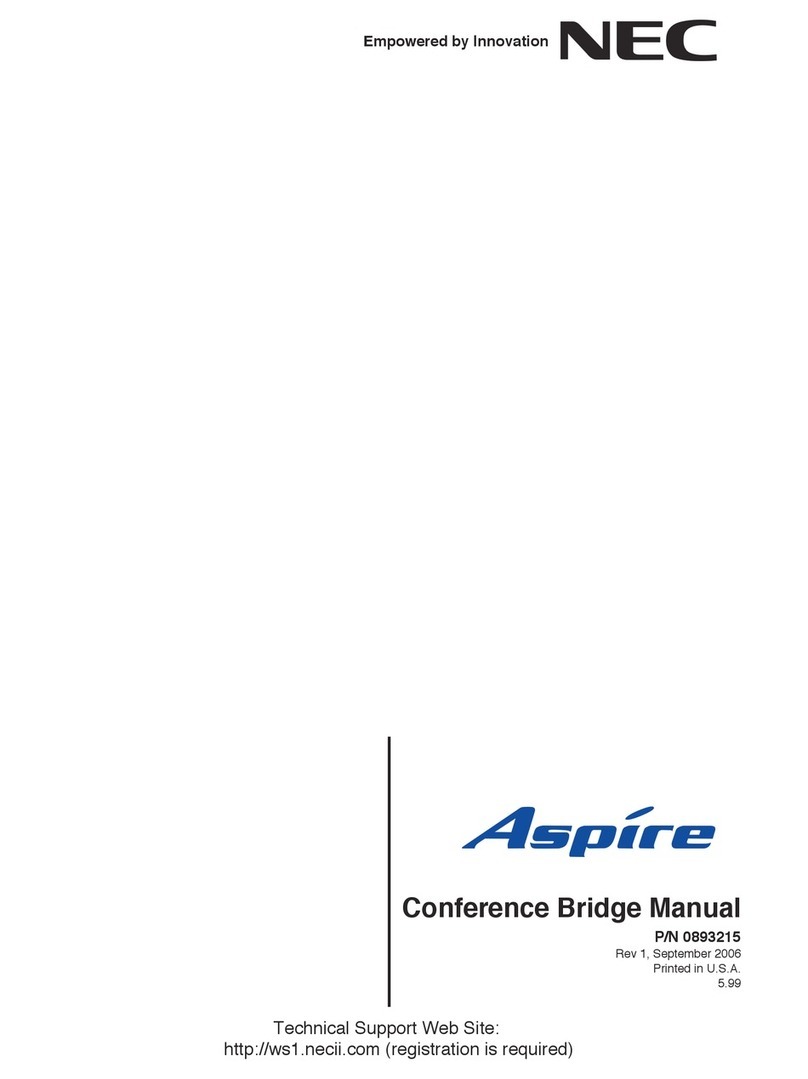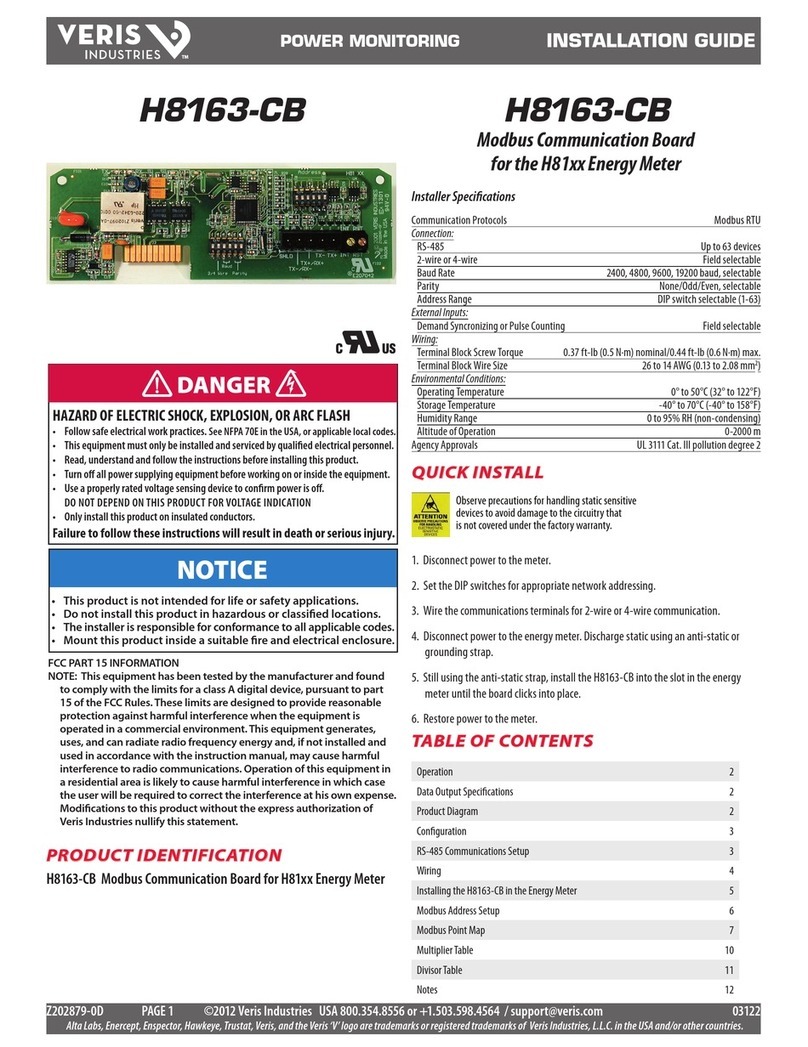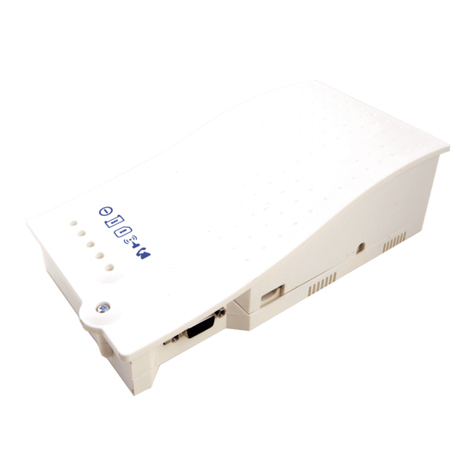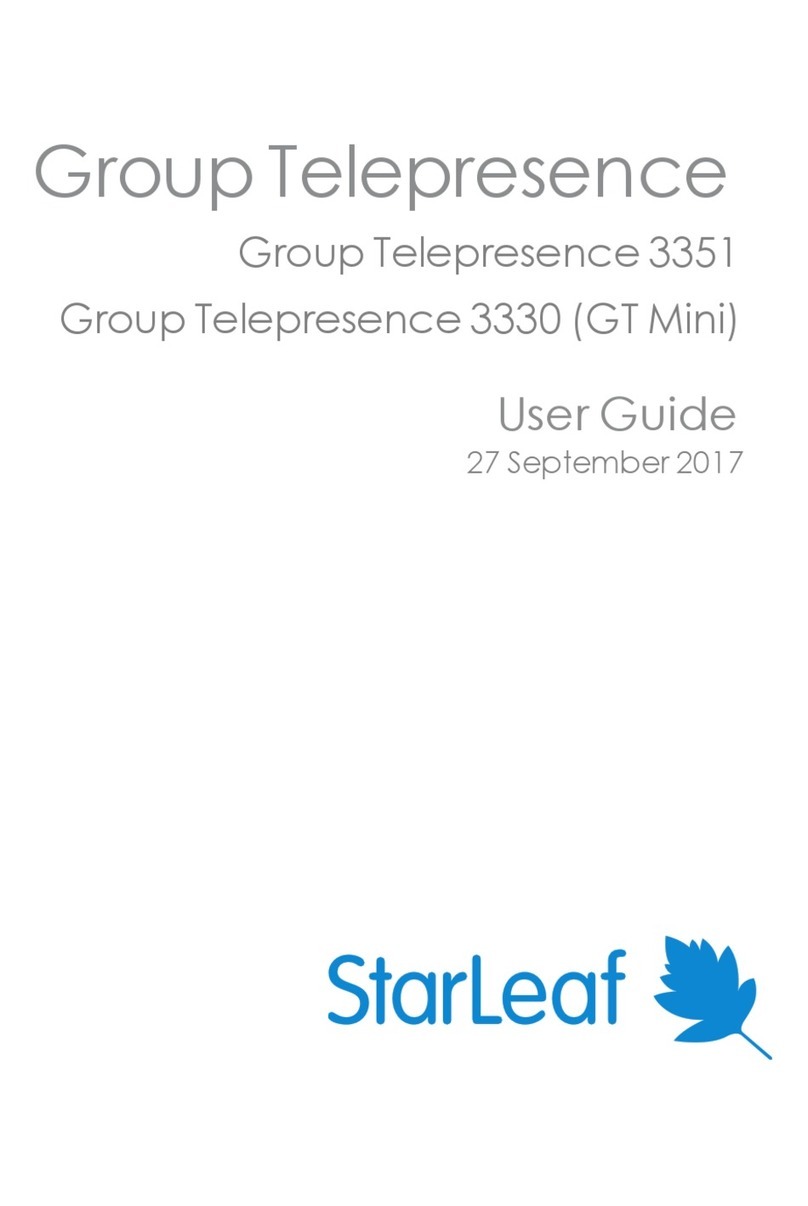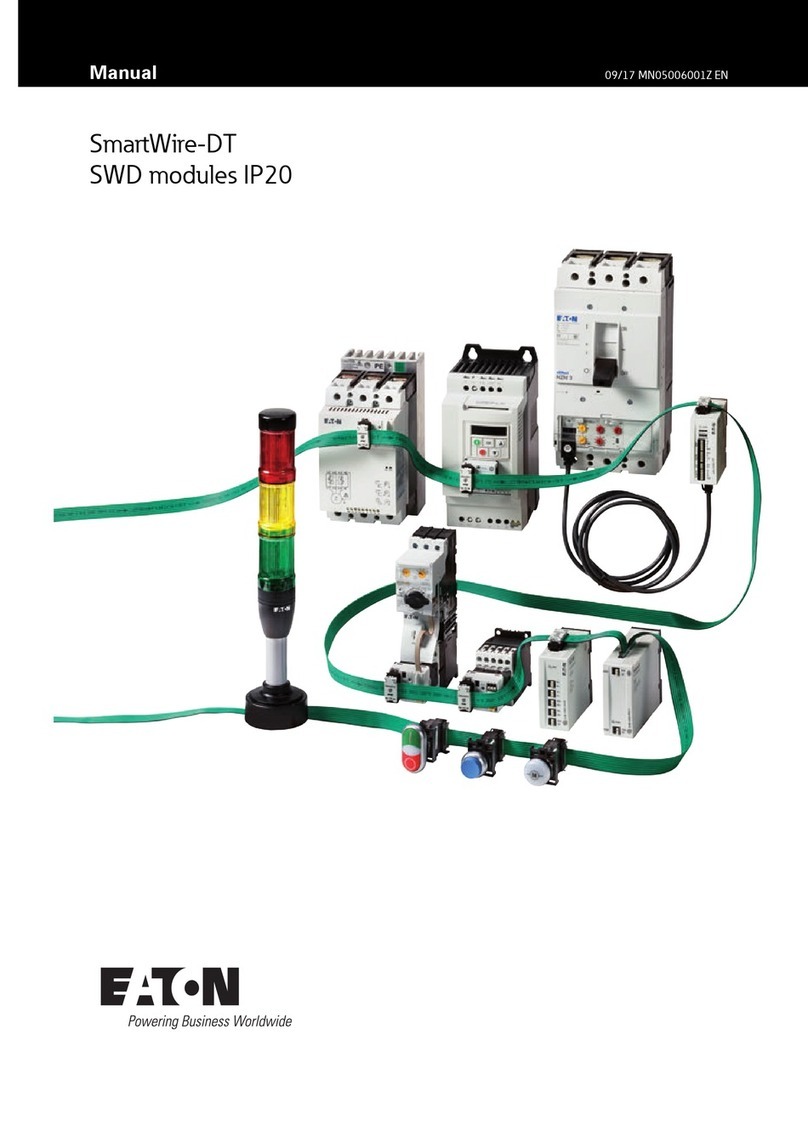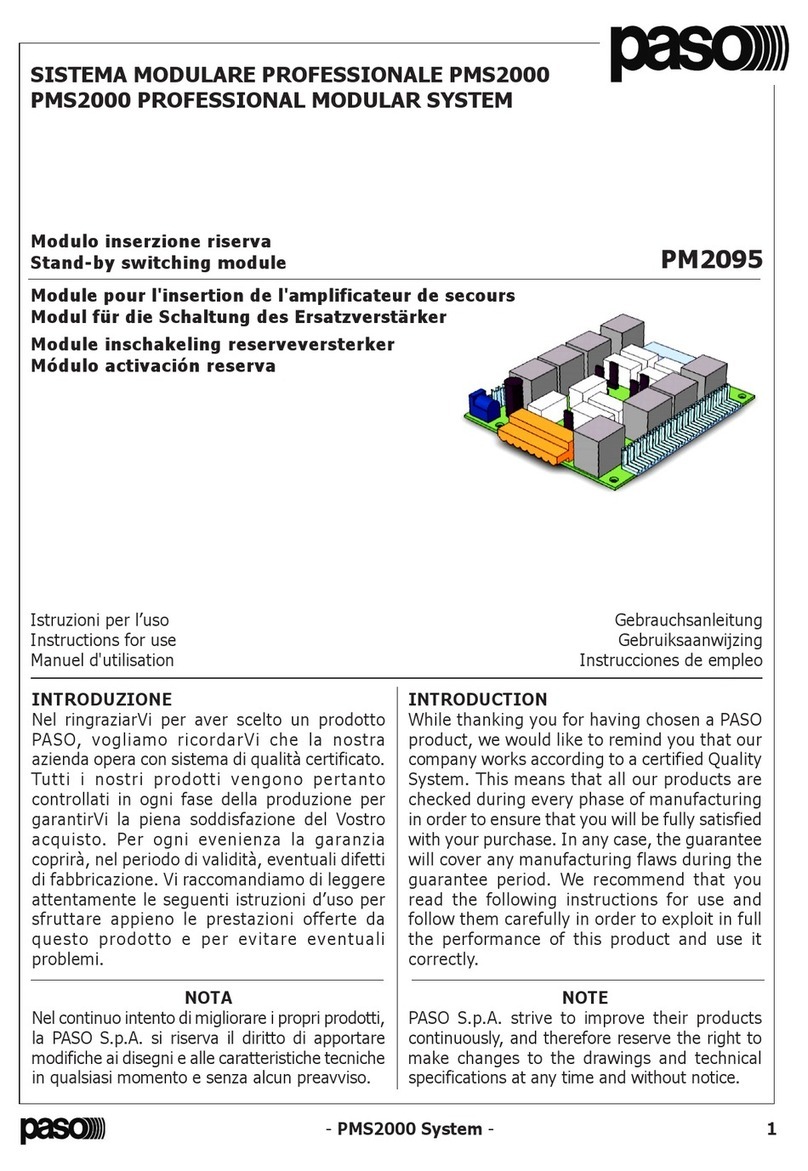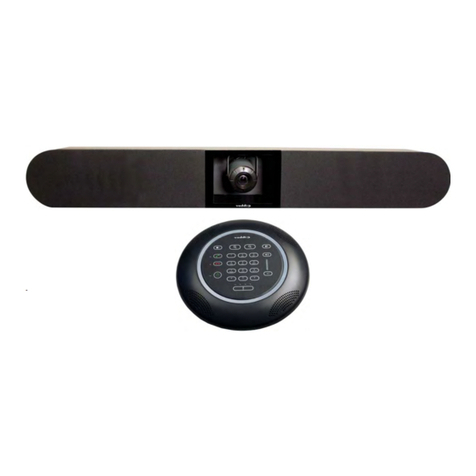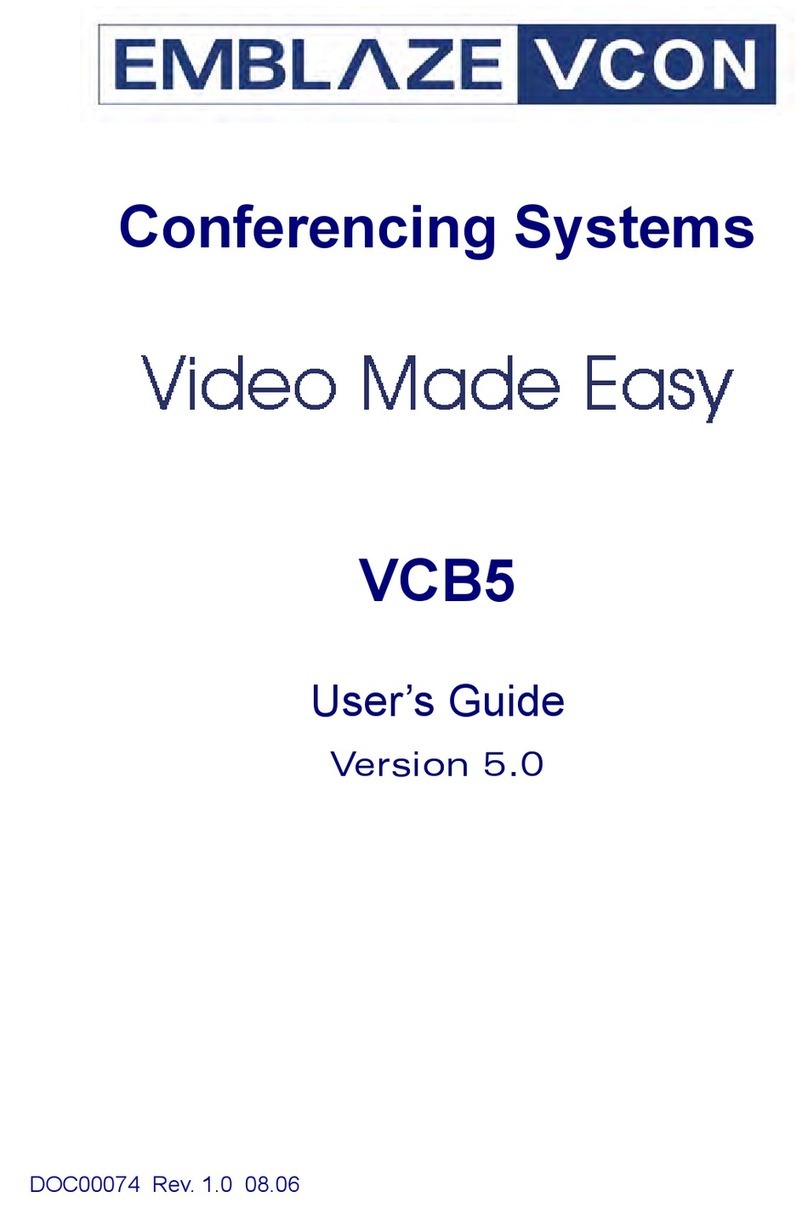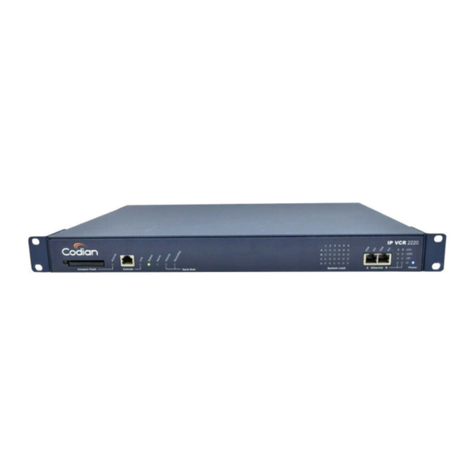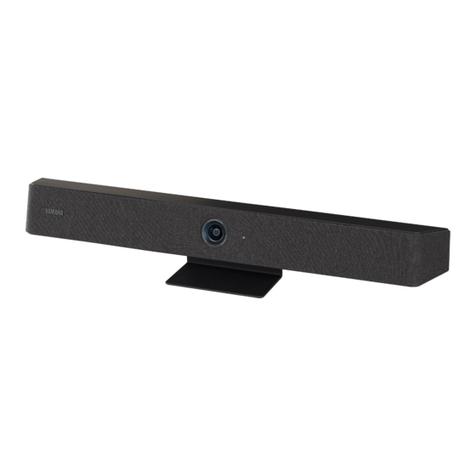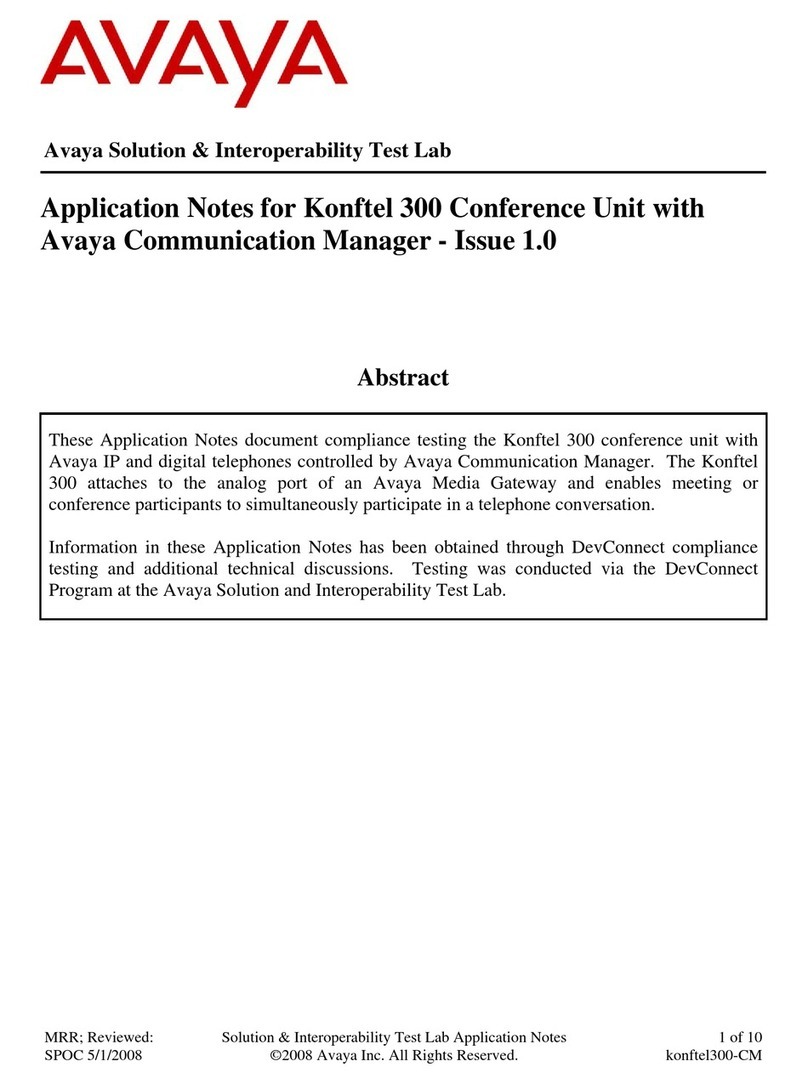Gentner XAP 800 Quick reference guide

1825 Research Way
Salt Lake City, UT 84119
1.800.945.7730
1.801.975.7200
www.gentner.com
© 2001 Gentner Communications Corporation. All rights reserved. Information in this document subject to change without notice.
803-151-101 Revision 1.0
XAP 800™
White Paper

TECHNICAL SUPPORT: 1.800.283.5936 (USA) OR 1.801.974.3760
1. Introduction . . . . . . . . . . . . . . . . . . . . . . . . . . . . . . . . . . . . . . . .2
2. Product Description . . . . . . . . . . . . . . . . . . . . . . . . . . . . . . . . . .4
. Echo and Noise Cancellation . . . . . . . . . . . . . . . . . . . . . . . . . . .9
4. Filters . . . . . . . . . . . . . . . . . . . . . . . . . . . . . . . . . . . . . . . . . . . . .1
5. Inputs and Outputs . . . . . . . . . . . . . . . . . . . . . . . . . . . . . . . . . . .17
6. Automatic Mic Mixing . . . . . . . . . . . . . . . . . . . . . . . . . . . . . . . .20
7. Audio Routing . . . . . . . . . . . . . . . . . . . . . . . . . . . . . . . . . . . . . . .26
8. Applications . . . . . . . . . . . . . . . . . . . . . . . . . . . . . . . . . . . . . . . . 0
9. Remote Control and Status . . . . . . . . . . . . . . . . . . . . . . . . . . . .4
10. Serial Remote Control . . . . . . . . . . . . . . . . . . . . . . . . . . . . . . .47
11. Programming . . . . . . . . . . . . . . . . . . . . . . . . . . . . . . . . . . . . . .48
12. XAP 800 Connections . . . . . . . . . . . . . . . . . . . . . . . . . . . . . . . .50
1 . XAP TH1 Telephone Interface . . . . . . . . . . . . . . . . . . . . . . . . .5
Appendices . . . . . . . . . . . . . . . . . . . . . . . . . . . . . . . . . . . . . . . . . . .54
XAP 800 White Paper
Gentner Part No. 80 -151-101
May 2001 (Rev. 1.0)
©2001 Gentner Communications Corporation. All rights reserved. No part of this document may be
reproduced in any form or by any means without written permission from Gentner Communications
Corporation. rinted in the United States of America. Gentner Communications Corporation reserves
specification privileges. Information in this manual is subject to change without notice.
able of Contents
T

TECHNICAL SUPPORT: 1.800.283.5936 (USA) OR 1.801.974.3760
INTRODUCTION • OVERVIEW
2
1
Audio is critical to human communication. Media such as voice mail, the Internet, conference
calling, videoconferencing, and electronic presentations are driving the demand for better
audio-communication technologies. The audioconferencing and videoconferencing arenas
also demand higher-quality sound. The XA 800 provides better sound quality as well as the
ability to provide total sound system performance for telecommunications and any other
multimedia audio event.
The XA 800 Audioconferencing System meets the demands of a wide variety of
conferencing and sound reinforcement requirements with 12 x 12 digital matrix mixing,
Gentner’s proprietary Distributed Echo Cancellation, noise cancellation, parametric
equalizers, filters, and 32 customizable presets. These features enable the XA 800 to create
a quality audio experience in many venues—from corporate briefing centers and courtrooms
to training rooms and boardrooms.
A quality teleconferencing experience is one where the audio or audio source material is the
message, not the audible inadequacies of a poorly designed or configured teleconferencing
system. With a properly configured XA 800, participants and observers do not become
fatigued by reverberated audio, which reduces sound clarity.
For ease of use, the XA 800 facilitates local and remote C setup, control, and diagnostics;
compatibility with custom control panels; integration with popular control systems; logic
outputs, and gated microphone operation. Microphone inputs and mic mixing parameters can
be individually customized, while automatic gain control keeps the overall sound level
consistent. Input channels 1-8 can be configured as an automatic microphone mixer.
Any combination of inputs can be routed to any combination of outputs, allowing flexibility in
accommodating different applications and customer requirements.
Adjustments in routing, level, and other functions can be made through presets activated
through a closure on the rear panel or an RS-232 serial interface.
Introduction
Overview

TECHNICAL SUPPORT: 1.800.283.5936 (USA) OR 1.801.974.3760
INTRODUCTION • OVERVIEW 3
The key benefits the XA 800 provides are:
High reliability
roven technology
Outstanding audio quality and clarity
Seamless integration to external control devices
Reduced number of separate audio devices required
Adaptability to a variety of sound applications
Expandability
Ease of design and installation
For more information about installing and configuring the XA 800, refer to the XA 800
Installation and Operation Manual.
This document outlines the features, functions, applications and technical details of the
XA 800. Some of the diagrams included here depict other Gentner products, such as the
XA TH1 Telephone Interface, A V200-I Video Codec, and A870 ower Amplifier. You
can find out the latest information on all Gentner products by calling us at 801.975.7200 or
800.945.7730; or visiting our Web site at www.gentner.com.

TECHNICAL SUPPORT: 1.800.283.5936 (USA) OR 1.801.974.3760
PRODUCT DESCRIPTION • INTRODUCTION
4
2
The XA 800 is a highly-advanced audioconferencing system with a twelve-by-twelve digital matrix mixer
Distributed Echo Cancellation, noise cancellation, and audio processing. It utilizes an internal macro language
and 32 user-definable presets to quickly adapt to a variety of sound reinforcement and room-combining
applications in courtrooms, multimedia centers, hotel/convention centers, conference rooms, training rooms, and
boardrooms.
Features:
Gentner’s proprietary Distributed Echo Cancellation. DEC places an acoustic echo canceller on each mic input
for greater echo cancellation flexibility and effectiveness.
Noise cancellation on each mic input to reduce unwanted ambient noise.
8 Mic/Line Inputs:
Input gain control
Configurable processors with 5 filters ( EQ, high-pass, low-pass, all-pass, and notch)
Automatic gain control with speech leveler for consistent audio levels
4 line inputs
Twelve line output channels. All output levels are adjustable and can be muted.
12 x 12 matrix mixer with level control at the cross points.
Any combination of inputs can be routed to any combination of outputs.
Adjustable automatic mic mixer:
8-channel automatic mix mixer. Up to 4 mixers operate across bus.
4 internal mixers
4 global mixers linked across Expansion Bus
Adjustable parameters
Look-ahead gating to eliminate clipped audio
Eight audio processing buses, each with 15 filters, can be placed anywhere within the matrix mixer audio path.
Remote and local C set-up and diagnostics.
All interconnected devices can be accessed, controlled, and programmed via a single RS-232 connection.
Macro ro scripting language allows the unit to function without an external control system.
32 programmable presets for instant configuration changes.
Network-based interconnectivity allows up to eight XA 800s to be connected and controlled as a single unit,
allowing 96 inputs and 96 outputs.
Logic outputs.
100 percent digital signal processing.
Gentner service and support.
Worldwide certifications for safety and emissions: CE, FCC, CSA, C-TICK registered.
One-year limited warranty.
Product Description
Introduction

TECHNICAL SUPPORT: 1.800.283.5936 (USA) OR 1.801.974.3760
PRODUCT DESCRIPTION • XA 800 BLOCK DIAGRAM 5
Input Gain
Phantom
Power
On/Off
Mic 55, 25
Line
Input Gain Input GainInput Gain Input GainInput Gain Input GainInput Gain
On
On On On On
Off
Off Off Off Off
Mute
Input Gain
Input
Processing
On
Off
Mute
Output
Gain
Off
NOM
On
Off
Mute
Input Gain
On
Off
Mute
Input Gain
On
Off
Mute
Input Gain Expansion Bus In/Out
Input 1 Input 2 Input 3 Input 4 Input 5 Input 6 Input 7 Input 8 Input 9 Input 10 Input 11 Input 12
Output 1 Output 2 Output 3 Output 4 Output 5 Output 6 Output 7 Output 8 Output 9 Output 10 Output 11 Output 12
Z Mixing Bus
On
Off
Mute
Output
Gain
Off
NOM
On
Off
Mute
Output
Gain
Off
NOM
On
Off
Mute
Output
Gain
Off
NOM
On
Off
Mute
Output
Gain
Off
NOM
On
Off
Mute
Output
Gain
Off
NOM
On
Off
Mute
Output
Gain
Off
NOM
On
Off
Mute
Output
Gain
Off
NOM
On
Off
Mute
Output
Gain
Off
NOM
On
Off
Mute
Output
Gain
Off
NOM
On
Off
Mute
Output
Gain
Off
NOM
On
Off
Mute
Output
Gain
Off
NOM
Phantom
Power
On/Off
Phantom
Power
On/Off
Phantom
Power
On/Off
Phantom
Power
On/Off
Phantom
Power
On/Off
Phantom
Power
On/Off
Phantom
Power
On/Off
Mic 55, 25
Line Mic 55, 25
Line Mic 55, 25
Line Mic 55, 25
Line Mic 55,25
Line Mic 55, 25
Line Mic 55, 25
Line
Matrix
Input
Processing Input
Processing Input
Processing Input
Processing Input
Processing Input
Processing Input
Processing
Assignable
Processing
Assignable
Processing
Assignable
Processing
Assignable
Processing
Assignable
Processing
Assignable
Processing
Assignable
Processing
Assignable
Processing
A
A
B
B
C
C
D
D
E
E
F
F
G
G
H
H
Outputs of Processing are looped back into the matrix.
MM M M M M M M M M M
M
AGC AGC AGC AGC
M M M M M M M M M M M M
To Matrix
From Matrix
Delay Comp/Limiter
15 Filters
Assignable Processing
All Pass
Low Pass
High Pass
LowShelving
High Shelving
500 mSAttenuation
Mute
M
PEQ
CDHorn
Bessel Crossover
Butterworth
Linkwitz-Riley
Control Bus
Y Mixing Bus
X Mixing Bus
W Mixing Bus
V Mixing Bus
U Mixing Bus
T Mixing Bus
S Mixing Bus
R Mixing Bus
Q Mixing Bus
P Mixing Bus
O Mixing Bus
Control/Status
B
Control/Status
A
Control
Logic
Front Panel
Control
Expansion Bus
RS485 Control
Network
RS485
RS232
On On On On On On On On On On On On
M= Meter Reference Point
Channel Mute AGC/SL
aOn/Off
On/Off
Echo
Cancellation
Noise
Cancellation
NLP
Selectable
EC Ref
Selectable NC Depth
Selectable AGC/Configuration SL
M
M
M
Notch
Notch
Figure 1. XAP 800 Block Diagram

Rear Panel Connections
1. ower - The power module accommodates an AC voltage input of
100–240VAC, 50/60Hz, 30W. No switching is required.
2. Inputs 1-8 - For mic- and/or line-level inputs.
3. RS-485 Remote Control orts - These four-pin hoenix™ ports allow
you to control the XA 800 with a Gentner Control anel.
4. Control/Status orts A and B - These DB25 connectors are for
connecting custom control devices. The control devices have access to
the command set for the XA 800 and can be used for functions such
as volume, muting, preset change, room combining, etc. Devices can
be connected to either port.
Figure 3. XAP 800 Rear Panel
Connections
123 4
5 789
TECHNICAL SUPPORT: 1.800.283.5936 (USA) OR 1.801.974.3760
PRODUCT DESCRIPTION • FRONT ANEL
Figure 2. XAP 800 Front Panel 1. LCD - Used for numeric display of audio levels, gain readouts, and
limited set-up and programming functions.
2. Enter/▲▼/ESC - Used to navigate the XA 800’s menu system.
3. LED Meter - This LED bar meter is used to display the audio level of
an input, output, or processing channel of the XA 800.
4. Meter - Takes you directly to the Meter branch of the XA 800’s LCD
programming tree.
5. Mic On LED - These LEDs indicate microphone gate status.
1 2 3 4 5

TECHNICAL SUPPORT: 1.800.283.5936 (USA) OR 1.801.974.3760
PRODUCT DESCRIPTION • REAR ANEL CONNECTIONS 7
5. Outputs 1-8 - Line-level outputs that may be configured for any combination of gated
and non-gated inputs, as well as a mix of mic- and line-level inputs.
6. Inputs 9-12- For line-level inputs.
7. Outputs 9-12- Same functions as Outputs 1-8.
8. Expansion Bus In/Out - Used for passing audio and control information between
XA 800 units.
9. RS-232 - This DB9 serial port is for interconnection between the XA 800 and a C,
modem, or popular custom remote control system.
Expansion Bus Connections
The Expansion Bus network architecture allows up to eight XA 800s and up to 96
inputs, 96 outputs, and 64 microphones to be controlled as if part of a single unit.
Expansion Bus This digital mix-minus bus allows audio routing to and from any
destination on the Expansion Bus network. It contains 12 independent digital audio
buses labeled O-Z and four A adapt/acoustic echo cancellation reference buses. Each
audio bus can route mic or line-level inputs across the Expansion Bus network. These
buses are divided into two groups—O-R buses and S-Z buses— based on their
capabilities and default settings.
O-R Buses These four audio buses are defaulted as the mic mix buses; they can
communicate the NOM count (see page 25) across the network to other XA 800s.
Otherwise, these buses are identical to buses S-Z.
S-Z Buses These eight buses are defaulted as auxiliary mix buses. They are used to
route auxiliary audio, such as from a CD player, video codec (such as the A V200-I ) or
XA TH1 Telephone Interface, to and from other units on the network. These buses are
also used as mic mix buses when NOM count is not required.
A Adapt/Acoustic Echo Cancellation Reference Buses These buses provide a system-
wide bus for input channels to receive a reference input for A Adaptive Mode. See
page 23 for more information about A Adaptive mode.
In addition, there are four global mixer groups (A-D). They support first-mic priority,
maximum number of mics, etc., and work across all linked XA 800s. Unlike the audio
buses, they contain only mic status and gate parameters. All gated mics are default
routed to the A mixer and to the O bus for routing.
Network Requirements
The Expansion Bus (RS-485 LAN) lets you link multiple XA 800s. The maximum
distance allowed between any two XA 800 units on an Expansion Bus network is 80
feet. Gentner recommends category five twisted-pair (10BaseT LAN) cable be used.

TECHNICAL SUPPORT: 1.800.283.5936 (USA) OR 1.801.974.3760
PRODUCT DESCRIPTION • INSTALLATION
8
Microphones PC (for set up;
not necessary for
system operation)
Logic Out
Status and
Control
XAP 8
XAP 800 Typical Installation
Tape Recorder
CD
PA87 Amplifier
Control
Panel
(optional) RS-485 RS-232
LR
Esc
sc
En
En
ter
er
Met
et
er
er
+12
+12
+8
+8
+8
+8
+4
+4
+4
+4
0
-4
-10
-10
-10
-10
-30
-30
-30
-30
1
2
3
4
5
6
7
8
Mic On
ic On
0AP 8 0
Transmit
ansmit
Rec
ec
eiv
eiv
eOn
On
Off
ff
HAP T 1
XAP TH1 Telephone Interface
APV2 -IP
Videoconferencing Codec
with RS-232 Control
Figure 4. Typical XAP 800 Installation
(simplified for illustrative purposes)
Equipment Placement
The XA 800 is designed for mounting in a 19" equipment rack. Do not block any of the
ventilation holes. With a desktop kit, it can be modified for tabletop placement.
Environmental Requirements
The XA 800 can safely operate in temperature environments between 32°—110°F.

TECHNICAL SUPPORT: 1.800.283.5936 (USA) OR 1.801.974.3760
Acoustic echo is a significant challenge to overcome in virtually any
teleconferencing environment. The effects of acoustic echo can destroy a
teleconference because it impairs participants’ abilities to understand and
communicate.
Acoustic echo is created when microphones pick up audio from a
loudspeaker and return it to the originating teleconference site. This echo
will cause a conference participant to stop speaking while trying to listen
to the echo.
One way to remove echo from your teleconference is to use an acoustic
echo canceller. An acoustic echo canceller samples audio coming in from
the remote site and prevents this audio from being sent back to the
originating site. To be most effective, each site should utilize an echo
canceller.
There are several factors that contribute to poor echo cancellation. These
include:
oor room acoustics
High reverberation
High noise
Rapidly changing acoustical environment
Wireless or other moving microphones
oor microphone/speaker placement
Automatic mic mixers not properly configured to work with an echo can-
celler
Other audio devices such as audio processors and user gain controls
that change the acoustic gain to which the echo canceller must adapt.
Echo and Noise
Cancellation
Echo Cancellation
ECHO AND NOISE CANCELLATION • ECHO CANCELLATION 9

TECHNICAL SUPPORT: 1.800.283.5936 (USA) OR 1.801.974.3760
ECHO AND NOISE CANCELLATION • ECHO CANCELLATION
10
Figure 5 shows a how a single echo canceller attempts to cancel echo in a room.
Audio from the distant room is sampled and used as a reference for the echo
canceller. When far-end audio is picked up by the microphone (acoustic echo),
the acoustic echo canceller senses the echo and builds an adaptive filter that
eliminates the echo.
Sample
;;;;
;;;;
;;;;
yyyy
yyyy
yyyy
;;;;
;;;;
;;;;
yyyy
yyyy
yyyy
;;;;
;;;;
;;;;
yyyy
yyyy
yyyy
;;;;;
;;;;;
;;;;;
yyyyy
yyyyy
yyyyy
;;;;
;;;;
;;;;
yyyy
yyyy
yyyy
;;;;
;;;;
;;;;
yyyy
yyyy
yyyy
Audio from
Distant room
Echo Cancelled
Audio
Acoustic Echo
Microphone Mixer
Sample
Figure 5. Single Echo Canceller
The XA 800’s Distributed Echo
Cancellation places an echo
canceller on each mic input for
dramatically improved echo
cancellation (see Figure 6).
In this example, audio from a
distant room is sampled. This
audio is a reference for each echo
canceller on every mic. When
sampled audio (acoustic echo) is
detected by the echo canceller,
the echo is eliminated.
SampleSample
;;;;
;;;;
;;;;
yyyy
yyyy
yyyy
;;;;
;;;;
;;;;
yyyy
yyyy
yyyy
;;;;
;;;;
;;;;
yyyy
yyyy
yyyy
;;;;;
;;;;;
;;;;;
yyyyy
yyyyy
yyyyy
;;;;
;;;;
;;;;
yyyy
yyyy
yyyy
;;;;
;;;;
;;;;
yyyy
yyyy
yyyy
Audio from
Distant room
Echo Cancelled Audio to distant room
Acoustic Echo
Microphone Mixer
=Acoustic Echo Canceller
A
E
C
A
E
C
A
E
C
A
E
C
A
E
C
A
E
C
A
E
C
Figure . Gentner’s Distributed Echo Cancellation

TECHNICAL SUPPORT: 1.800.283.5936 (USA) OR 1.801.974.3760
ECHO AND NOISE CANCELLATION • NOISE CANCELLATION 11
The XAP 800 Advantage
The XA 800 overcomes acoustic echo cancellation challenges through the use of
Gentner’s proprietary Distributed Echo Cancellation technology. Unlike older
systems, which use a single echo canceller across all audio sources in the system,
Distributed Echo Cancellation dedicates an echo canceller to each mic input. The
DEC system is far more effective in canceling echo, resulting in clearer, more
accurate echo cancellation. The DEC system can also track changes in the room
environment more effectively, keeping the audio quality at the highest level.
The advantages of Distributed Echo Cancellation include:
Significantly better echo cancellation in a wider variety of acoustical environments
lug and play echo cancellation
Faster convergence time
Better full duplex
Reduced noise and suppression
Increased gain
Higher tolerance to room and network audio level changes
Instead of a single echo canceller covering the entire room, an echo canceller is put
on every acoustic (mic) input. In a room of eight microphones, a DEC system would
have eight echo cancellers. Each echo canceller must work only on one acoustic
reference. Obviously, such an echo canceller has a far easier time canceling echo
than a single echo canceller with eight acoustic references. In addition, when
compensation techniques are required for times when echo cannot be fully canceled
(suppression, center clipping, etc.), the compensation effects are heard only on the
single microphone channel, rather than the entire mixed audio source. This greatly
improves full duplex, noise, gritch, and compensating audio level reduction.
Noise Cancellation
Today’s hi-tech microphones are becoming more sensitive, which means the
chance that simple sounds will be detected and amplified is much higher.
Some of these sounds include:
Heating, ventilating and air conditioning (HVAC).
Fluorescent light ballasts, generators, power cords, and other electrical
items that generate low-level (60Hz) hum in amplification equipment.
ortable devices such as laptops and overhead projectors have fans can
transmit on frequencies that are occasionally detected and amplified.

TECHNICAL SUPPORT: 1.800.283.5936 (USA) OR 1.801.974.3760
ECHO AND NOISE CANCELLATION • NOISE CANCELLATION
12
Elimination of Noise
Since the term "noise" covers a variety of unwanted audio generated by many different sources, there is also a
variety of ways to cancel the noise.
Most noise can be eliminated by:
Acoustical treatments in and around noise sources.
Conducting microphone placement tests.
Reducing the amount of reflective surfacing.
Identifying and reducing or eliminating hum.
Using quality, shielded cable and connectors.
Using a noise cancellation device, such as that found in the XA 800.
Gentner’s XA 800 features a revolutionary new algorithm that actively eliminates background noise within the
vocal range on each mic input. Unlike other noise canceling devices, the XA 800 does not simply gate audio off
when a mic input drops below a specified level. Gentner’s noise cancellation actively separates and attenuates
ambient noise from the speech signal, leaving speech audio virtually untouched. It effectively reduces noise
between 20Hz and 20kHz.
Gentner’s noise cancellation also ensures that your entire system functions more efficiently. Noise not only interferes
with human communication, it unnecessarily hampers all sound system components (i.e., DS s, amplifier power,
loudspeaker bandwidth), thereby significantly decreasing a system’s power and responsiveness. By reducing
signals unassociated with human speech, the XA 800 ensures the entire system sounds clearer and is much more
efficient and responsive.
Noise Cancellation vs. Echo Cancellation
Since the job of any sound system is to amplify audio signals, all noise is picked up and amplified. Even barely
audible signals may become very loud once picked up by a sound system. However, unlike echo cancellation, noise
cancellation is much more challenging because it lacks a reference signal. Despite these challenges, Gentner’s
revolutionary noise canceller discerns and actively tracks ambient noise and eliminates it from the final mix.
The XA 800’s noise canceller is an excellent complement to the acoustic echo canceller. This is because it
reduces ambient noise, which can cause the echo canceller to deviate from an optimal echo cancellation solution.
By reducing much of the ambient noise, it ensures the echo canceller has the purest, most accurate room reference
by which to cancel echo.

TECHNICAL SUPPORT: 1.800.283.5936 (USA) OR 1.801.974.3760
4
The XA 800 features the power of eight processing blocks, which are
dedicated signal processing resources that can be applied to any mic
or line input routed to it. Within each processing block, compression,
delay, gain adjustments, and up to 15 different filters may be applied to
any mic and/or line input routed to the block. Each input also has up to
four assignable filters for shaping the input’s audio response.
For example, say you have a conferencing scenario in which mics
connected to input 1 and 4 are having feedback problems. The
problem frequencies could be attenuated in each mic input, or both
mics could be assigned to processing block A, where problem
frequencies are attenuated. In the future, other microphones can also
be routed to the same processing block and will therefore receive the
same feedback cancellation—without any additional adjustments.
Microphones not routed to processing block A would be unaffected by
these filters.
Feedback
erhaps the most common (and most annoying) problem for
professional sound engineers is feedback. Feedback is often a high,
piercing tone caused when mics pick up a particularly resonant
frequency and amplify it through the sound system, where it is picked
up again by the microphones—this time louder—and the process is
repeated.
Filters
Processing Blocks
FILTERS • ROCESSING BLOCKS 13

TECHNICAL SUPPORT: 1.800.283.5936 (USA) OR 1.801.974.3760
FILTERS • FEEDBACK CONTROL
14
In addition to being painful to hear, feedback can also cause amplifiers to clip, and
can destroy drivers and loudspeaker components. While most feedback can be
controlled by proper microphone placement, resonant frequencies can be attenuated
using filters like parametric equalizers.
Low frequency feedback isn’t necessarily audible, but it decreases the system’s power
and responsiveness. By attenuating the low-end frequencies (low cut/high pass) not
needed for vocals, the XA 800 system operates more efficiently because it doesn’t
need to allocate resources to produce low frequencies throughout the system.
XAP 800 Feedback Control System
The XA 800 includes a number of highly customizable filters that are excellent tools
for feedback control. These filters boost or attenuate certain audio ranges,
compensate for poor acoustical environments, and generally fine-tune your sound
system. Some filters, such as pass filters, allow you to select a range of audio
frequencies above or below a given point and attenuate it, while others allow you to
attenuate specific frequencies. Filters are also excellent for use in canceling out
frequency ranges that cannot be transmitted through telephone lines, thereby freeing
up the system’s resources.
The XA 800 features the following filters:
All Pass: A filter that provides only phase shift or phase delay without significantly
changing the magnitude of the signal. Useful in custom crossovers designed to
compensate for loudspeaker driver deficiencies.
CD Horn Equalizer: A constant directivity horn driver has an inherent 6dB/octave
high frequency roll-off. This device products a 6dB/octave boost to compensate. The
CD horn device is implemented using a high shelving filter. The level control is fixed at
+12dB, and is hidden.
High Pass: Allows frequencies above a designated frequency to pass while
attenuating those below it. erfect for attenuating low, rumbling noises like those
captured by a microphone when placed on a stage, table or in a microphone stand.
High Shelving: Boosts or attenuates frequencies above a designated frequency while
leaving those below it unaffected. The transition between the spectrum above and
below the designated frequency occurs at a fixed 6dB/octave rate. When boosted, it
enhances the higher, more intelligible aspects of the vocal range. When cut, it is
excellent for avoiding resonant frequencies (feedback) and ranges of extraneous
sibilance (like a constant "ssssssss" noise).

TECHNICAL SUPPORT: 1.800.283.5936 (USA) OR 1.801.974.3760
FILTERS • FILTERS AND CROSSOVERS 15
Low Pass: Allows frequencies below a designated frequency to pass while attenuating those
above it. Useful for reducing overall sibilance and avoiding shrill resonant frequencies (feedback).
Low Shelving: Boosts or attenuates frequencies below a designated frequency, leaving those
above it unaffected. The transition between the spectrum above and below the designated
frequency occurs at a fixed 6dB/octave rate. Excellent for enhancing the low-end range of a
signal.
Notch Filter: A band-stop filter that can remove a select range of frequencies. Commonly used
for removing specific resonant frequencies from a system.
Filters for the XA 800 are configured in G-Ware software. Refer to page 42 to see the filter
configuration window in G-Ware.
Parametric Equalizer: A multi-band variable equalizer that allows the user to define the
amplitude of the filter, shift the center frequency of the filter, and control how wide the range is to
which the equalizer is applied. Excellent for general tone shaping or feedback removal.
The XA 800 also features a crossover function. The crossover combines high-pass and low-pass
filters that divide a full-range signal into separate frequency ranges. These ranges can then be
sent to amplifiers and loudspeakers optimized for producing those respective frequency ranges.
Band-pass filters can be designed by overlapping high-pass and low-pass filters.
For example, the bottom end of a frequency range might be defined as 400Hz and lower. This
signal might then be heavily compressed and sent to bass bins and woofers powered by
amplifiers. The midrange (say, 400Hz to 5kHz) can be sent to full-range loudspeakers. The high
end (say, 5kHz and above) can be directed to smaller amplifiers and associated tweeters, piezos,
horns, etc.
The XA 800 includes three types of crossovers: Butterworth, Bessel and Linkwitz-Riley. Each of
these is characterized by the steepness of their roll-off slopes (the rate of attenuation outside their
passbands). Crossovers in the XA 800 are created by assigning the appropriate type of high-
pass filter in a processing block with the complementary low-pass filter in a separate processing
block.
Bessel Crossover: Utilizes a low-pass filter design characterized by having a linear phase
response (or maximally flat phase response), but also a monotonic decreasing passband
amplitude response (which means it starts rolling off at DC and continues throughout the
passband). Linear phase response (e.g., a linear plot of phase shift vs. frequency producing a
straight line) results in constant time-delay (all frequencies within the passband are delayed the
same amount). Consequently, the value of linear phase that reproduces a near-perfect step
response (there is no overshoot or ringing resulting from a sudden transition between signal
levels). The drawback is a sluggish roll-off rate. For example, for the same circuit complexity, the
response for a Butterworth crossover rolls off nearly three times as rapidly.

TECHNICAL SUPPORT: 1.800.283.5936 (USA) OR 1.801.974.3760
FILTERS • CROSSOVERS
1
Butterworth Crossover (1 pole): A type of crossover circuit low-pass filter
design characterized by having a maximally flat magnitude response (i.e., no
amplitude ripple in the passband).
Linkwitz-Riley (LR-4) Crossover (2 poles): The 4th-order (24 dB/octave
slope) Linkwitz-Riley (LR-4) design represents a vast improvement over the
previous 3rd-order (18 dB/octave) Butterworth standard. It consists of a
cascaded 2nd-order Butterworth low-pass filter, and is considered the de facto
standard for professional active audio crossovers.
The XA 800 also has an intuitive filter display, which shows the aggregate filter
response in a particular processing block. This display can also overlay the
filter responses of other processing blocks, which is useful in designing active
crossovers. The aggregate phase response of the processing block can also
be shown superimposed on the filter response curve.

TECHNICAL SUPPORT: 1.800.283.5936 (USA) OR 1.801.974.3760
INPUTS AND OUTPUTS • LEVEL CONTROL 17
5
The XA 800 has 12 inputs consisting of eight mic/line inputs and four line inputs. The unit has
12 line outputs.
All inputs and outputs are actively balanced. Inputs 1-8 have 4kOhms of terminating
impedance while line-level inputs 9-12 provide >20kOhms of termination. Outputs provide a
source impedance of 50 Ohms. All levels are referenced to a 0dBu level.
Input and output level control is executed in the digital domain. As a result, input levels should
never exceed +20dBu. The unit will deliver a maximum output level of +20dBm. The XA 800
utilizes 24-bit A/Ds and D/As while sampling at a 48kHz rate. This results in a system-wide
dynamic range of 100dB, a pass band from 20Hz to 20kHz, and a SNR >100dB at maximum
input level. All input and output levels can be monitored in real time on the front-panel LCD and
through the RS-232 serial port. The LCD display and RS-232 port provide precise numeric
readouts indicating level. This allows extremely precise level calibration. Additionally, while
monitoring numeric dBu audio levels, input and output gains can be adjusted for optimum
audio performance.
Inputs 1-8
Balanced audio is input at the rear panel hoenix™ connector. Mic or line level is selected and
phantom power is provided (if required). The XA 800 then converts this audio from analog to
digital for processing by the DS engine. Once converted to digital, audio is level controlled.
This function, along with all other input and output controls, can be adjusted via the RS-232
port and/or the control pins on the control/status connector. This provides for real-time audio
volume control, muting, etc. Minimum and maximum levels can also be set to limit the range of
gain to suit audio requirements.
The acoustic echo canceller/speech leveler is the first option in the audio signal flow. Here, you
set the echo cancellation reference, non-linear processing (optional), and meters reflecting
echo cancellation activity. You can also enable the noise canceller and depth of cancellation.
Next, four configurable filters can each be set individually as an all-pass filter, a low-pass filter, a
high-pass filter, a parametric equalizer ( EQ), or notch filter. Each may be activated to equalize
Inputs and Outputs
Input and Output
Level Control

TECHNICAL SUPPORT: 1.800.283.5936 (USA) OR 1.801.974.3760
INPUTS AND OUTPUTS • IN UTS 1-8 ARAMETERS
18
different microphones to sound similar, filter out unwanted hum, etc. You can increase
or decrease each band up to 15dB, in increments of .5dB on each input.
The next option is the automatic gain control (AGC) and speech leveler. The purpose of
the AGC is to automatically increase gain when the level is too low and decrease gain
when it is too high. AGC is provided at all inputs and should be activated for
microphones or line inputs that experience audio level fluctuation. The speech leveler
targets speech audio and equalizes the audio levels of someone who is speaking close
to a mic and someone who is speaking from farther away. For example, if audio coming
from a video codec fluctuates (depending on the connection at the other end), the AGC
will compensate for these differences.
After the channel mute stage, non-gated audio is applied to the routing matrix for
outputs that need direct audio. The final stage (automixing) determines how the audio
is directed into the post-gating input to the routing matrix. Each input can be set for a
variety of automixing functions, including activation settings, chairman mic, and
adaptive ambient mode. The functions determine when, how, and why an individual
microphone will gate on or off:
Microphone Activation. There are two modes of mic activation that can be selected
on a per-input basis: auto-gate and manual gate on/off. In auto-gate mode, the input
channel is voice activated, based on the programmed automixing system parameters.
In manual gate mode, the mic is activated by manually switching it on or off and
allowing the input to contribute to automixing parameters.
Chairman Override (On or Off). Each gated input may be selected as a chairman
override input. This feature adds this input to the chairman override group and, when
gated on, gates off inputs that are not in the chairman override group.
Channel Mute AGC/SL
aOn/Off
On/Off
Echo
Cancellation
Noise
Cancellation
NLP
Selectable
EC Ref
Selectable NC Depth
Selectable AGC SL
5
Notch
Figure 7. Inputs 1-8 Parameters

TECHNICAL SUPPORT: 1.800.283.5936 (USA) OR 1.801.974.3760
INPUTS AND OUTPUTS • IN UTS 9-12 19
On Off
Input
Gain
Input
9-12
On Off
Mute To Matrix
AGC
Figure 8. Inputs 9-12
Adaptive Ambient (On or Off). In the ON mode, the ambient level used to
calculate gating is based on the room’s actual noise floor, integrated over time, as
measured by the input in the room. In the OFF mode, the manual ambient level is
set by the integrator, and will be used to calculate gating.
Figure 8 shows inputs 9-12. These line-level inputs can be level controlled, muted,
and gain controlled through the AGC. All of these functions operate identically to
inputs 1-8.
Outputs
All 12 of the line outputs are identical, as shown in Figure 9. Three functions are
associated with each output: gain control, mute, and NOM (number of open mics).
Gain control allows you to set the output level. the min/max controls allow you to set
minimum and maximum gain levels that the user will be limited to. The mute function
essentially turns the volume off. All of these functions can be controlled via the RS-232
port or the control/status connector. An example would be if you want to control the
volume of the speakers—you could use two control pins on the control/status
connector for volume up and volume down. Another pin could be used for mute.
Activation of NOM places this output ONLY in a mode where, as more microphones
routed to this output are gated on (either by auto gate or manual gate), the total overall
output gain will remain constant. This reduces the possibility of feedback occurring.
A feature of the XA 800 is its ability to provide NOM at every output. Most automixers
have a single master NOM output. NOM is used to maintain a constant acoustic gain in
the room, permitting the system to optimize its gain before feedback status. This is
most useful in sound reinforcement applications.
Outputs
1-12
On Off
Mute
On Off
NOM
Output
Gain
From
Matrix
Figure 9. 12 Outputs from Matrix
Other manuals for XAP 800
2
Table of contents
Other Gentner Conference System manuals

Gentner
Gentner Audio Perfect 800 User manual

Gentner
Gentner Audio Perfect 400 User manual

Gentner
Gentner XAP 800 User manual

Gentner
Gentner ET100 User manual

Gentner
Gentner XAP 800 User manual

Gentner
Gentner GT300 User manual

Gentner
Gentner Audio Perfect Video 200 User manual

Gentner
Gentner TI7200 User manual

Gentner
Gentner ET10 User manual
